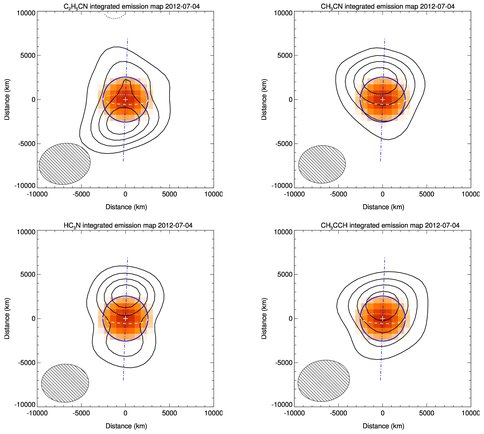2015 Annual Science Report
 NASA Goddard Space Flight Center
Reporting | JAN 2015 – DEC 2015
NASA Goddard Space Flight Center
Reporting | JAN 2015 – DEC 2015
Interstellar and Nebular Chemistry: Theory and Observations
Project Summary
We continue to undertake theoretical and observational studies pertaining to the origin and evolution of organics in Planetary Systems, including the Solar System. In this performance period, we have focused on studies aimed at understanding the origin and processing of organics in the earliest evolutionary phases of stars like the Sun. These include formation pathways and related isotopic fractionation effects.
We have continued observational programs designed to explore the chemical composition of comets and establishing their potential for delivering prebiotic organic materials and water to the young Earth and other planets. State-of-the-art international facilities are being employed to conduct multi-wavelength simultaneous studies of comets in order to gain more accurate abundances, distributions, temperatures, and other physical parameters of various cometary species. We are also leading an international collaboration to study the organic composition of Titan with the Atacama Large Millimeter Array (ALMA).
Project Progress
We have continued our studies of organic chemistry in the interstellar medium and during the earliest stages of formation of Solar-type stars. These include observational studies of nitrogen fractionation (Wirstrom et al. 2015) and organic molecule production and destruction in the protostellar environment (Taquet et al. 2015). A theoretical study was completed on the formation of complex molecules in the envelopes of protostars undergoing periodic luminosity outbursts, and has been submitted for publication. Our work on the ISM-nebula chemical connection was summarized in a large review paper (Willacy et al. 2015).
A major part of our efforts supported by the NAI are in remote observational programs designed to explore the chemical composition of comets and establishing their potential for delivering pre-biotic organic materials and water to the young Earth and other planets. We have continued a program of interferometric and single-dish mm/sub-mm cometary observations at various observatories in the US and abroad. These include the Atacama Large Millimeter Array (ALMA) in Chile, the Arizona Radio Observatory’s Sub-millimeter Telescope, the JCMT, NRAO GBT 100m and APEX. A study of the volatile production in comet C/2009 P1 (Garradd) was published (Gicquel et al. 2015) and the first detections of ethanol and glycolaldehyde in a comet were reported (Biver et al. 2015). We used ALMA to determine the utility of the methanol molecule for measuring the physical conditions in the coma of comet C/2012 K1 (PanSTARRS) (see Figure 1), and a paper has been accepted for publication.
We also contributed to three major reviews concerning cometary composition, isotopic fractionation, and the data required from future laboratory experiments (Cochran et al. 2015; Bockelée-Morvan et al., 2015; Gudipati et al. 2015).
We have continued our successful program of data-mining the ALMA archive, using Titan molecular spectra obtained originally as calibration measurements. During this performance period we published the first spectroscopic detection of ethyl cyanide in Titan’s atmosphere, along with HC3N, CH3CN, and CH3CCH (Cordiner et al. 2015). Surprisingly, ethyl cyanide was enhanced over Titan’s South polar region, while HC3N, CH3CN, and CH3CCH were enhanced over the North (see Figure 2). We also submitted a paper reporting the detection of all C and O isotopologues of CO on Titan.
Publications
- Biver, N., Bockelée-Morvan, D., Moreno, R., Crovisier, J., Colom, P., Lis, D. C., … Milam, S. N. (2015). Ethyl alcohol and sugar in comet C/2014 Q2 (Lovejoy). Science Advances, 1(9), e1500863–e1500863. doi:10.1126/sciadv.1500863
- Bockelée-Morvan, D., Calmonte, U., Charnley, S., Duprat, J., Engrand, C., Gicquel, A., … Wirström, E. (2015). Cometary isotopic measurements. Space Sci Rev, 197(1-4), 47–83. doi:10.1007/s11214-015-0156-9
- Cochran, A. L., Levasseur-Regourd, A-C., Cordiner, M., Hadamcik, E., Lasue, J., Gicquel, A., … Kuan, Y-J. (2015). The composition of Comets. Space Sci Rev, 197(1-4), 9–46. doi:10.1007/s11214-015-0183-6
- Cordiner, M. A., Palmer, M. Y., Nixon, C. A., Irwin, P. G. J., Teanby, N. A., Charnley, S. B., … Wang, K-S. (2015). Ethyl cyanide on Titan: Spectroscopic detection and mapping Using ALMA. The Astrophysical Journal, 800(1), L14. doi:10.1088/2041-8205/800/1/l14
- Gicquel, A., Milam, S. N., Coulson, I. M., Villanueva, G. L., Cordiner, M. A., Charnley, S. B., … Szutowicz, S. (2015). The evolution of volatile production in Comet C/2009 P1 (Garradd) during its 2011-2012 apparition. The Astrophysical Journal, 807(1), 19. doi:10.1088/0004-637x/807/1/19
- Gudipati, M. S., Abou Mrad, N., Blum, J., Charnley, S. B., Chiavassa, T., Cordiner, M. A., … Yang, R. (2015). Laboratory studies towards understanding Comets. Space Sci Rev, 197(1-4), 101–150. doi:10.1007/s11214-015-0192-5
- Taquet, V., López-Sepulcre, A., Ceccarelli, C., Neri, R., Kahane, C., & Charnley, S. B. (2015). Constraining the abundances of complex organics in the inner regions of Solar-type Protostars. The Astrophysical Journal, 804(2), 81. doi:10.1088/0004-637x/804/2/81
- Willacy, K., Alexander, C., Ali-Dib, M., Ceccarelli, C., Charnley, S. B., Doronin, M., … Zicler, E. (2015). The composition of the Protosolar Disk and the formation conditions for Comets. Space Sci Rev, 197(1-4), 151–190. doi:10.1007/s11214-015-0167-6
- Wirström, E. S., Adande, G. R., Milam, S. N. Charnley, S. B., Cordiner, M.A. (2015). 15N fractionation in star-forming regions and Solar System objects. Astronomy in Focus, in press
-
PROJECT INVESTIGATORS:
-
PROJECT MEMBERS:
Martin Cordiner
Co-Investigator
Stefanie Milam
Co-Investigator
Gilless Adande
Postdoctoral Fellow
-
RELATED OBJECTIVES:
Objective 1.1
Formation and evolution of habitable planets.
Objective 1.2
Indirect and direct astronomical observations of extrasolar habitable planets.
Objective 2.2
Outer Solar System exploration
Objective 3.1
Sources of prebiotic materials and catalysts
Objective 3.2
Origins and evolution of functional biomolecules
Objective 7.1
Biosignatures to be sought in Solar System materials
Objective 7.2
Biosignatures to be sought in nearby planetary systems


